
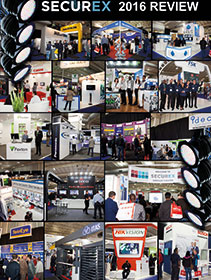
Securex 2016 was, by all accounts, a successful event for both exhibitors and visitors. The halls of Gallagher Estate were packed with people from the first day to the last, with a significant number of people attending the various presentations put on throughout the event.
ESDA Breakfast
The event was kicked off early on the Tuesday morning with the ESDA breakfast. ESDA, the Electronic Security Distributors Association, hosted a full house of members and their customers to a hearty breakfast, hosted by the chairperson, Lee-Ann Andreka.
Andreka welcomed everyone to the event and introduced Specialised Exhibitions’ Joshua Low, the event director. Low made a short speech welcoming everyone to Securex 2016, mentioning there were 160 exhibits from over 20 countries, with 45 new companies on the show this year. Andreka then introduced the keynote speaker of the morning, Alderman JP Smith, Cape Town’s Mayoral Committee Member for Safety and Security.
Alderman Smith spoke about the role technology plays in combating crime, with specific examples from Cape Town’s remarkable successes. (A brief overview of Smith’s five pillars to a safer city can be found at www.securitysa.com/8533a.) These successes not only include bringing crime statistics down, but also a reduction in the number of deaths as a result of residential fires (from 7.9 per 100 000 of the population in 2009, to 3.6 per 100 000), and a remarkable decline in road deaths (from 2200 down to 1200) as a result of a Metro Police Service focused on traffic enforcement instead of revenue collection.
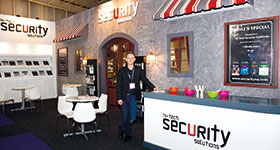
Smith explained that government is not an early adopter of technology and therefore needs industry to support it in rolling out working solutions. The standards adopted in Cape Town’s safety initiatives were co-opted from a variety of sources, including local neighbourhood watches and private security companies. The city has also drawn on the expertise available from international police forces who have shared best practises with Cape Town’s law enforcement members.
Bringing the statistics down has not been an easy journey, nor is the journey completed. Smith says the city tried several things, failed on some and succeeded with others. One of the success stories, which will be expanded, is that of specialised units. Instead of having a police force that is meant to deal with everything, specialised units focus on specific areas of crime and have produced good results. Part of the success is finding and hiring experienced leaders to bring proven expertise to the units. Using specialised Metro Police units, gang crimes, for example, have seen a 20% reduction in two years.
Of course, the successes obtained came after the city took responsibility for its own safety initiatives and over the course of a few years increased its policing resources by 70%. This includes 500 ‘Rent-A Cops’ which work in various City Improvement Districts. It is also a result of commitment and involvement from citizens who ‘do their bit’ to help secure the environment they live in.
The city’s CCTV usage will also expand, both from cooperation with private concerns determined to play their part in making Cape Town a safe environment for everyone, as well as the city’s own cameras, more of which will be rolled out in the coming year. There are already over 460 ANPR (automated licence plate recognition) cameras the city can access to track vehicles of interest.
The coming year will also see a larger reliance on intelligence in effective policing, with data gathered from cameras and other locations accessible via dashboards in the control centre as well as on tablet computers in Metro Police vehicles. Cape Town will also be commissioning drones to assist in its safety initiatives, allowing authorities to ‘get eyes on a situation’ quickly and safely.
In summing up, Smith said that cooperation from the business world and private citizens has played a significant role in Cape Town being able to turn the seemingly unstoppable growth of crime, something other cities can only hope to emulate.
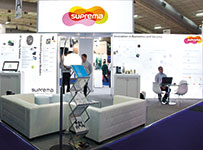
On with the show
Following the breakfast, the show itself opened and the first day proved to be an extremely busy one with visitors flocking to the stands (traditionally the first day is the slowest). While a couple of the ‘big names’ were missing, their absence was hardly noticed as their places were filled with a host of other companies showing off their wares, which included everything from security clothing to remote controls, access control, perimeter and guard management solutions, to CCTV, intrusion, safes and a host of other systems and solutions.
It goes without saying that we can’t feature all the companies on show in a short review such as this one. What we have done is highlight a few of the companies we met; with additional input later in the review form others.
On the CCTV front we start with Axis. The company had a large stand as always with a host of products on display, from its multi-sensor panoramic cameras, through to its XF40-Q1765 explosion protected fixed network camera and XP40-Q1765 explosion protected PTZ network camera. Which both feature a 316L stainless steel housing certified for hazardous areas according to, amongst others, ATEX, IECEx, cLCus and Class I, II/Div 1 for OSHA.
Axis also showed off its first 4K PTZ dome camera, a discrete 720p modular camera, its light finder technology which allows cameras to see in almost total darkness as well as an impressive demonstration of its Zipstream technology which can reduce the bandwidth video requires without compromising important images.
Also on display was the company’s access control systems which, while still fairly new, are creating a new market for the company, especially with its acquisition of 2N (see the news section of this publication).
Bosch Security was also at the show, a first-time exhibitor, demonstrating a range of products. The display included Bosch’s surveillance cameras, including one which spent the show submerged in water while the images it produced were displayed on a screen. Bosch also had four IP cameras in a dark box, where it showed their low-light capabilities. With minimal light, the cameras were able to display the scene in the box, with the 5 MP camera leading the way in terms of clarity.
The company also had its public address systems on display. These systems can serve multiple zones and provide the ability to create individual emergency messages (or announcements made in the normal course of business) for each zone. They can be linked to fire alarms to ensure the occupants of buildings are evacuated as soon as a fire is detected, thereby ensuring maximum safety for all concerned. Bosch also has PA systems designed for entertainment venues. These systems can be managed remotely via a smartphone or tablet if required.
The company also had its access control systems on display, as well as a range of new intruder products which it is introducing to the African market.
Canon made its second appearance at Securex, this year with a much bigger stand. Visitors were able to gain insight into, among others, its 1.3 MP PTZ network camera with low light functionality and 5x optical zoom. With a high-sensitivity sensor and high-performance image processor, the camera can produce images of a subject’s face with recognisable colour from 90 metres away in ambient light levels equivalent to moonlight (0.08 lux).
Canon has established itself as a significant surveillance player in the local market in a short time and the company has made a number of international acquisitions in its quest to gain $1 billion in annual revenues from its surveillance solutions.
Once again, Hikvision was there also with a large stand displaying its range of products, from megapixel cameras to its consumer range, as well as its more recent alarm and entrance solutions. The company has also made the move into thermal cameras and it had the yet-to-be released PanoVu multi-sensor 360-degree camera on display. For the analogue fans among us, Hikvision also displayed its 5 MP TVI high-definition analogue cameras and recorders.
Hikvision’s strategy is also to focus on verticals where its products can form part of a total solution. One area is in the licence plate recognition market. The company has two primary cameras with ANPR software built in to speed the deployment of an ANPR solution.
Among the other well-known surveillance companies at Securex 2016 were Geovision, TeleEye, Flir, Panasonic (another new entrant), Frank Street and a few new Chinese companies with large stands, among them Dahua, Cantonk, Longse and ZNV. The UK’s Reveal Media was also there with its body-worn solutions.
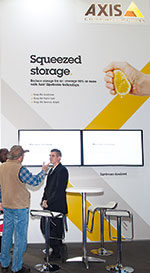
Making software work for you
Supporting the wide range of cameras on the show were companies with video management software (VMS) designed to help users get the most out of their video surveillance. Of these, local VMS developer Cathexis was on show to display the latest its CatVision IP video management software can manage, which includes hundreds of surveillance cameras from a variety of manufacturers.
Among the latest features Cathexis was talking about were its automatic number plate recognition (ANPR) capabilities, the new Advanced Video Search and Adjacent Camera Mapping features, as well as its improved hardware efficiency which allows more cameras to be managed on the same server.
Graphic Image Technologies (GIT) was also there. GIT supplies a range of product, both hardware and software, including the Flir range of cameras (which includes the DVTel range). GIT also supplies the SerVision range of solutions for transmitting video over very low bandwidth connections, as well as body worn and mobile solutions.
GIT demonstrated its DVTel (now Flir) NVRs as well as its VMS, which offers adaptive streaming. This functionality allows a company to stream 4K video at a lower resolution to a control room. When the operators need to view a specific area of the image, they can zoom in on that area and the system automatically increases the resolution to allow them to see the details clearly. While this is happening, the full image is still being recorded and can be viewed on other screens.
The system also allows for intelligent searching, which can for example, show all the movement in a specific area over time. The system delivers all the images within that time period when movement was detected. When searching for missing objects, for example, the user can use the search function to steadily narrow down the time surrounding the objects description to quickly find the footage of it being taken.
Once again, Milestone Systems occupied a large stand at Securex with numerous solutions from the company and its partners on display. Of the various solutions on the stand, the new Husky M500 NVR with Milestone XProtect Expert preloaded, with the option to select XProtect Corporate, stood out.
What makes the M500 different is that its internal systems have been optimised to provide the best video surveillance handling possible. This means that it can support 512 720p cameras with a guaranteed recording performance of 600 Mb/s. The NVR has a versatile design to be a recording server, failover server, management server and can also be used as an all-in-one video solution.
To ensure it provides the optimal surveillance experience, the Husky M500 Advanced uses Western Digital Purple hard drives, which are designed for video surveillance operations. It also supports up to 48 TB of internal raw storage and has the ability to archive to network-attached storage appliances when additional storage is required.
Arteco also put in an appearance at Securex, demonstrating its open platform VMS software, which has integrated numerous camera and other manufacturers’ functionality into its core. Arteco produces hardware and software for the video surveillance industry.
A bit of networking
IP convergence company MiRO was once again at Securex, exhibiting its range of products in the wireless and surveillance arenas as well as its software and analytics offerings. MiRO offers holistic security solutions and would fit into a variety of categories in the security market.
In the surveillance market, MiRO took on the Uniview brand of cameras, recorders and software this year. Uniview boasts some advanced networking auto adaptability protocols in its cameras that allow uninterrupted communication, even where slow or low bandwidth is an issue, such as remote monitoring over the Internet. Vivotek products, a brand associated with MiRO for a long time were also available on the stand.
In the wireless networking area, the company showed its new Siklu brand MiRO is now distributing. This wireless Ethernet solution offers connectivity at Gigabit speeds in the interference-free and licence-exempt 60 GHz spectrum. Siklu point-to-point links are fast to deploy to backhaul capacity-hungry video surveillance cameras, Wi-Fi hotspots, Gigabit-To-The-Home (GTTH) and business broadband services.
Duxbury Networking was also on show again. Under the spotlight were next-generation firewalls and unified threat management (UTM) appliances from Cyberoam Technologies. Wireless networking was also a feature on the stand, with brands like Cambium, Mimosa and Rajant, complemented by Netgear networking and storage solutions as well as Lantech products. ACTi IP cameras and NVRs were also in the spotlight.
Workforce management and T&A
Two companies making their presence felt in the workforce management and time & attendance (T&A) fields were Instacom and Econz Wireless.
International company, Econz Wireless has been providing solutions to the security market for decades and is making its presence felt in South Africa. In the T&A field, the company helps managers eliminate paperwork by using mobile devices to log and track people. Its Econz Eservice GPS is a mobile field service dispatch and work order management system. It is web-based software that enables a field service team to receive and respond to customer work orders.
Econz Timecard GPS is a mobile time, attendance and GPS Tracking application for companies where time and attendance tracking is helpful for ensuring job completion and maintaining accurate records of working hours and job types. Building contractors, home healthcare, security guards, distribution, utilities, services and manufacturing companies can all benefit. Timecard Lite GPS is a timecard GPS application without the time and attendance reports, aimed at companies looking for GPS tracking.
Instacom is also in the business of making use of rugged mobile devices to facilitate easier communication between people, such as guards and their control centres, or any mobile staff. Not only are workers able to communicate using the company’s Push-to-Talk solution, they can also be located via the rugged smartphone and the system can be used to allocate patrols, check in at specific points and incorporated into a company’s workflow, again keeping electronic instead of paper records. The Instacom solution allows companies to ditch their 2-way radios in favour of a rugged smartphone that is loaded with a host of additional functionality.
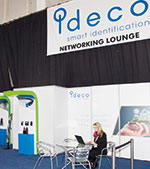
Biometrics and access control
Just as there were many companies offering surveillance products along with a variety of integrated solutions, the access control and biometrics market was also very well represented. And as we are seeing a renewed interest in access control globally, these companies have evolved from simply delivering products to offering integration into almost any other aspects of access and security.
ZK Teco was again one of the first companies seen as one entered the hall. With an even larger stand than 2015, ZK offered visitors an overview of numerous products it has on offer, from simple access, electronic locks and biometric products to more complex solutions for T&A and more. It also demonstrated its entrance control turnstiles and barriers, allowing visitors to experience them in action.
Morpho, now simply known as Safran, was another regular on the show. Although the MorphoWave was launched in South Africa at Securex 2015, the system still impresses in recognising four fingerprints as the user simply glides their hand over the sensor. Of course there were more products on display, such as the recently launched MorphoAccess Sigma Lite Series which includes two design options, one offering an interactive 2.8-inch colour touch screen and the other features a LED indicator to assist users in the access control process. Both designs offer multiple card reader options (Prox, iClass or MIFARE/DESFire).
Safran partner, Powell Tronics was also there, not only demonstrating its product range, but its integration capabilities that work with the products it distributes. This resulted in the company talking about and showing its own P-Tron and ATOM product ranges, as well as Safran, Impro and Golmar solutions.
No stranger to Securex, Suprema’s stand invited visitors to view and talk about the various products on display as well as the integrated solutions Suprema’s distributor, neaMetrics could offer the security market. Securex marked Suprema’s début of its new fingerprint IP terminal, BioStation A2, which features a quad-core CPU. The terminal can match up to 150 000 fingerprints per second, which makes it the fastest biometric terminal in the world. Along with an increased 8 GB memory, BioStation A2 can store up to 500 000 users and provides instant results with minimal lag time.
Suprema also offered the BioStation L2 fingerprint terminal. A mid-range device that can support enterprise-level requirements in both access control and time and attendance applications, along with Live Finger Detection and the latest OP5 sensors. Incorporating the latest fingerprint algorithm and powerful
1.2 GHz quad core processor, the L2 uses parallel processing techniques that result in fast matching speed that rival higher-end models. Loaded with 2 GB flash and 256 MB RAM, BioStation L2 stores and manages up to 500 000 users and 1 million logs.
Visitors to the Suprema stand could also hear about various value-added integrations into Gallagher, Avigilon Access, Impro Portal, Saflec Access Control, Paxton Access, CathexisVision and MileStone VMS, to name a few.
Ideco hosted the networking lounge once again and had its new Biometric Identity Management System (BIMS) on display. BIMS was recently launched in the USA to rave reviews and is sure to establish the company as a world-beater when it comes to identity management in the 21st century.
BIMS offers six biometric modalities in one portable device and delivers a full range of connectivity options, including Bluetooth, Wi-Fi, GSM and LAN. Multi-functional and configurable, the unit has been designed to the world’s most stringent hardware and software security standards, and harnesses intelligent power management for prolonged battery life of up to 12 hours.
Intrusion and perimeter
Nemtek was back at Securex again, displaying its various products for the electric fencing industry, including its new energiser which can be integrated into other security solutions. The company also spoke to Hi-Tech Security Solutions about its certified training facility for electric fence installers.
Paxton was also on show with its network access systems. Dan Drayton, country manager for Paxton said: “Securex was a successful event for us as it provided an excellent opportunity to meet with our existing installers and distribution partners. Some very productive meetings were held on the stand enabling us to introduce our product range and easy to install solutions to a number of new customers. Plus, our licence-free software and market- leading 5-year swap out warranty continue to be an attractive offer to installers across the country.”
FSK Electronics took the opportunity to introduce visitors at Securex to its new locally manufactured Rhino high performance hybrid alarm panel and the Raptor remote. The Raptor is the first bi-directional, shock resistant, water resistant long-range remote control that operates on its own licensed frequency, not 433 MHz or 868 MHz, thereby reducing potential jamming threats. It is also immune to false decoding and interference. It includes additional facilities to control other household equipment, such as switching on the lights etc.
A mobile app has been designed that makes managing the whole process much easier, allowing users to have insight into their own security alerts in collaboration with their service providers. It also allows users to remotely arm or disarm their systems, or certain areas of their house. For example, when the family is home, they may decide only to arm the perimeter and not the internal systems.
The above were only a few of the attractions at Securex 2016. The show was packed with exhibitors and there was also the seminar theatre where numerous presentations were heard. We only heard a few of the presentations, but from what we saw, they were definitely worth the time.
Focus on verticals
Powell Tronics’ decision to move the focus away from pure products to a concentration on four distinct vertical market sectors at Securex 2016, has paid dividends for the company. John Powell, CEO of the company says the strategic design elements of the stand resulted in a pleasing number of qualified leads.
A variety of decision makers from large corporate companies as well as installers, major utilities and government departments took the opportunity to discuss customised solutions with the Powell Tronics technical and sales specialists.
The back wall of the stand displayed an integrated solution that included Morpho’s Sigma family, including the new Sigma Lite products and Impro’s Portal range, standard biometric terminals and Morpho 3D face readers all running on a Portal backbone and incorporating short-range and long-range RFID via Impro and NEDAP products.
There was great interest in Powell Tronics’ own ATOM software solutions. Particularly attractive is the functionality and cost effectiveness of the web-based ATOM time and attendance software, providing users with many of the time and attendance capabilities of much more capital-intensive software. Furthermore, because the software is developed locally, it is highly relevant to the local market and technical backup is readily available.
Powell Tronics used Securex as an opportunity to promote team building, with its entire sales and development team constantly interfacing with potential customers and suppliers. “Securex 2016 has once given us an opportunity to expand our customer footprint and based on its unrivalled brand promotion ability, we have already secured our stand space for 2017,” Powell concludes.
Quality visitors and interactions
Suprema Securex 2016
This year’s show was a big success. It was well organised with quality visitors and extremely valuable interactions that opened several new partnerships with well-established system integrators, security consultants and security related manufacturers and distributors. It also provided a comfortable platform for strengthening relationships with current clients.
This year Suprema launched the new revolutionary high-end A2 and essential L2 Access and Time Attendance terminals. Both presenting the new international standard for access and time architecture, offering 100 000 fingerprint matches per second, Live Finger detection and ultra-user data transfer speeds. This will be the minimum standard for all Suprema terminals going forward. Reinforcing this, is the launch of BioStar 2.2, which offers extended T&A functionality through its web and mobile platforms while enabling cloud functionality where required.
As always the custom value-adds were one of the major attention grabbers which included the new AndroID T&A extension and EasyRoster workforce management. The R&D team showed off the integration of the IoT with Bluetooth proximity, biometric passport and automation control wrapped up in a custom mobile application to register visitors at the stand.
We were also extremely proud to win the best stand (48 m2 plus) this year and want to thank DK Design, employees and partners that made this possible! We are looking forward to increasing our presentation, products and partnerships again with the next Securex.
Expectations met
By Laurence Smith, executive at Graphic Images Technology.
Our experience of Securex this year was marked by an increased interest specifically in our (Graphic Image Technologies’) mobile CCTV platforms from SerVision. We believe the interest effectively shows that the market is moving across and has acknowledged its need for mobile CCTV which offers the ability to watch live cameras from within a vehicle as it is on the road. This is especially useful for deployment in cash in transit vans and public transport systems.
We were also pleased with the positive reception of the announcement that DVTEL has been acquired by FLIR and now forms part of the FLIR solution offering. In addition, we noticed that attention shifted towards 4K (Ultra-HD) cameras this year.
GIT’s expectations of Securex were definitely met, and we’re positive that a substantial amount of business will result from our networking and interactions with potential customers at the event. At Securex 2017 we look forward to seeing how technology has changed and advanced in the next year, and hope that we’ll have some new, exciting products to introduce at the same time.
| Tel: | +27 11 543 5800 |
| Email: | malckey@technews.co.za |
| www: | www.technews.co.za |
| Articles: | More information and articles about Technews Publishing |
© Technews Publishing (Pty) Ltd. | All Rights Reserved.